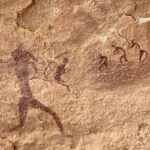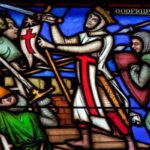We explain what is called a primitive community, in what prehistoric era it existed and what its main characteristics were.

What was the primitive community?
According to anthropological interpretations that emerged in the 19th century, the primitive community was the oldest stage of social, political and economic organization of the human species. That is, it was the way human groups were organized during most of prehistory. This concept is also sometimes used to define contemporary indigenous communities that maintain lifestyles considered “primitive” by Western researchers.
According to the defenders of this concept, the primitive community is characterized by having life patterns based on subsistence, that is, they produce what is necessary to live and not to accumulate surpluses. In this sense, primitive communities usually practice hunting, gathering, fishing, horticulture or some incipient form of agriculture. In historical terms, the primitive community was the characteristic mode of organization of the Paleolithic, Mesolithic periods and the beginning of the Neolithic revolution (which in the Near East took place around 8500 BC), which involved the adoption and gradual expansion of agriculture and livestock.
Primitive communities were modest in size (they could have a few dozen or hundreds of members), at least in comparison with the fully sedentary societies that grew during the Neolithic period and led to the emergence of the first States and cities. exercised various forms of cooperation between individuals and families, which allowed the subsistence of the population as long as it did not grow too much and its needs did not exceed the productive capacity of the group.
Yes ok accumulation of assets was not the norm especially among nomadic communities, horticultural societies or societies with incipient agriculture could reserve some resources for specific situations (such as festivities, rituals, famines or armed raids). Other activities, such as artistic expression and religious worship, were not as elaborate as in the agricultural civilizations of later times but were important, as demonstrated by cave paintings and other archaeological evidence.
The concept of primitive community derives from an ethnocentric and evolutionary perspective characteristic of the anthropology of the 19th century and the beginning of the 20th century. This view considered any form of social organization that did not coincide with the urban, state and modern way of life as an inferior or primitive social model. This perspective was questioned by some anthropologists starting in the second half of the 20th century, who observed that human societies should be studied based on their own cultural particularities and not based on an evolutionary scale that takes as a parameter of superiority or progress the researcher's own society.
Primitive community in Marxist theory
Within Marxism, the primitive community roughly corresponds to the concept of primitive communism, that is, the mode of tribal and community socioeconomic organization prior to the emergence of private property. According to Karl Marx (1818-1883) and Friedrich Engels (1820-1895), this initial organization was most suitable for a nomadic or semi-nomadic human community, which lived by hunting, fishing and gathering. In it, goods were shared among all its members and social class distinctions did not exist because they were unnecessary.
Key points
- The primitive community was humanity's first mode of social organization, generally characterized by a nomadic or semi-nomadic lifestyle.
- Their economy was based on hunting, gathering, fishing and, in some cases, horticulture or incipient forms of agriculture.
- In the primitive community, productive surpluses were not accumulated, except for special situations, and there were no social classes or private property.
- The concept of primitive community, applied to prehistoric societies and some contemporary indigenous communities, is rejected by various anthropologists who consider it a legacy of 19th century ethnocentrism.
- In Marxist theory, the primitive community corresponds to the evolutionary concept of “primitive communism,” developed by Marx and Engels.
See also: Prehistory
Characteristics of the primitive community
The main characteristics of the primitive community are:
- It has a generally nomadic or semi-nomadic way of life, and their subsistence is based on hunting, fishing, gathering and, in some cases, horticulture or incipient forms of agriculture.
- It does not produce productive surpluses nor has accumulation purposes except to carry out certain activities (such as rituals) or to face critical situations (such as possible shortages).
- Its economy is not based on private property but in the collective usufruct of resources. Furthermore, their society is not divided into social classes but is organized based on kinship relationships.
- The community is usually self-sufficient and their individuals or household units usually make their own tools, so there is usually no economic exchange, trade or barter. However, there may be exchange of gifts with other communities and internal relationships of reciprocity and mutual aid.
- Supports a division of labor according to age and sex based on the physical capabilities of individuals, but does not promote a division of labor based on specializations or professions with different remunerations, as is characteristic of urban societies.
- Their work tools are usually rudimentary although functional. Its materials are usually stone, bone, wood and, through contact with hierarchical, state or modern societies, various metals.
- Their social structure is usually patriarchal (that is, family and community authority is exercised by men, specifically heads of families). Family affiliation, for its part, can be through patrilineal or matrilineal transmission, that is, in some cases the line of descent is defined by the father and in others by the mother.
- The absence of an organ of central political power means the nonexistence of a State since political organization is based on kinship relations, cooperation within the community and the possible presence of prestigious leaders associated with specific areas (such as religion, hunting or war).
- Their intimate relationships are usually organized on the basis of the prohibition of incest (the search for consorts outside the kinship group). Sometimes polygamy can be practiced, either polygyny, in which the man has more than one wife, or polyandry, in which the woman has more than one husband.
- Some scholars define it as a subsistence society since its low level of production is fundamentally oriented towards sustenance. However, others characterize it as a society of abundance, since its low level of production is the result of a deliberate decision to reduce the time dedicated to work in order to carry out other non-productive activities.
- Their beliefs and religious cults are usually associated with phenomena or objects of nature such as atmospheric phenomena, fertility, the animal world, the natural landscape and the cycles of birth and death.
The primitive community in anthropology
The concept of primitive community is very attached to the origins of anthropology which throughout the 19th century and the first half of the 20th century frequently maintained an ethnocentric view. For example, in his work primitive society (1877), the evolutionary anthropologist Lewis Henry Morgan (1818-1881), who in turn influenced the ideas of Marx and Engels, divided the history of humanity into three stages: savagery, barbarism and civilization.
In this way, for evolutionary anthropologists, all forms of organization that were simpler or smaller in scale than Western industrial society were considered less developed, which in reality revealed an ideology that considered the researcher's own culture as superior or more advanced. At the lower end of this evolutionary scale were the so-called primitive communities, which tended to lack writing, strong political hierarchies, and tendencies to accumulate surpluses.
For this reason, Some anthropologists in the second half of the 20th century began to question the use of the terms “primitive community” and “primitive society.” especially when reflecting on contemporary indigenous societies. These anthropologists pointed out that so-called primitive societies should not be defined by what they did not have (compared to state and modern societies), but should be characterized according to their own social and cultural particularities.
For example, the anthropologist Marshall Sahlins (1930-2021) observed that some communities that do not produce surpluses do not have a deficiency in developing their economy but simply prefer to work only the time necessary to guarantee subsistence and dedicate the rest of the time to other activities (such as rituals or various forms of leisure).
document.addEventListener(“DOMContentLoaded”, (e) => { var sliderContainer, slider; sliderContainer = document.getElementById(‘block_7eb94d373d7958aed7dcdd397dcdc137’); if (typeof initSlider !== ‘function’) { console.log(‘Swiper haven\’t been loaded’); sliderContainer.className += ‘ fw scroll-snap’; return; }; options = { direction: ‘horizontal’, speed: 1000, slidesPerView: ‘auto’, // slidesPerGroup: 1, centerInsufficientSlides: true, // centeredSlides:true, spaceBetween: 15, breakpoints: { 720: { // centeredSlides: false, // slidesPerGroup: 2, spaceBetween: 25 }, }, pagination: { el: ‘.swiper-pagination’, type: ‘bullets’, clickable: true }, } slider = initSlider(sliderContainer, options); })
References
- Clastres, P. (2001). Research in political anthropology. Gedisa.
- González Alcantud, JA (1998). Anthropology (and) politics. On the cultural formation of power. Anthropos.
- Graeber, D., & Wengrow, D. (2022). The dawn of everything. A new history of humanity. Ariel.
- Sahlins, M. (1987). Stone Age Economy. Akal.
- Service, E. R. (2023). Primitive culture. Encyclopedia Britannica. https://www.britannica.com/





